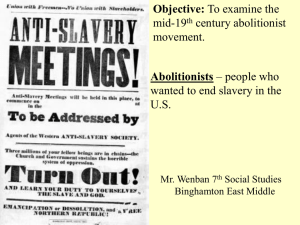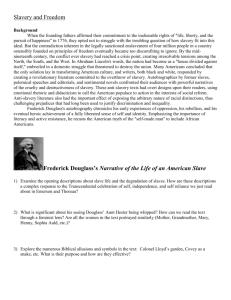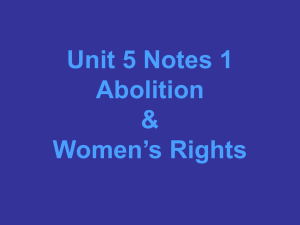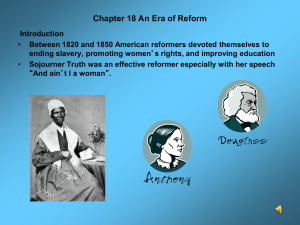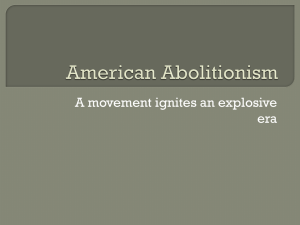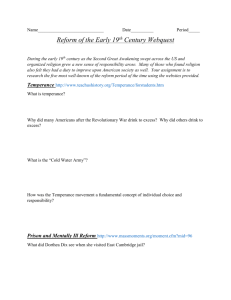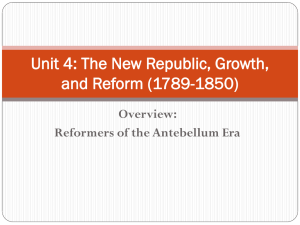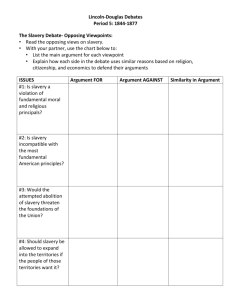The Reform Era - Wyckoff School District
advertisement
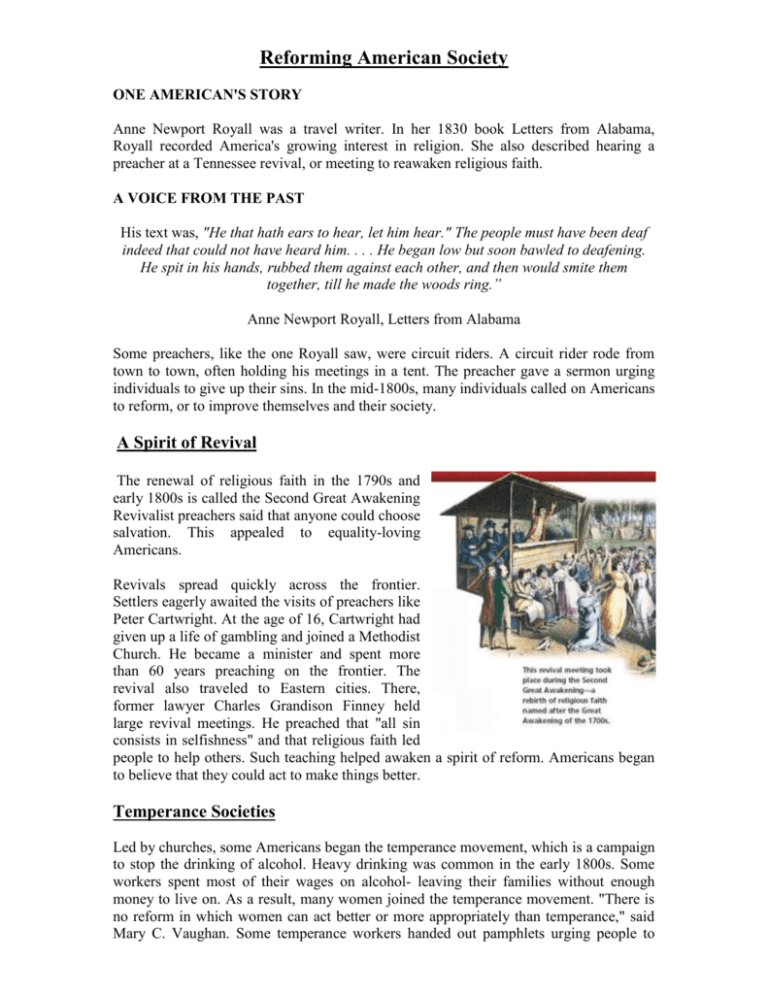
Reforming American Society ONE AMERICAN'S STORY Anne Newport Royall was a travel writer. In her 1830 book Letters from Alabama, Royall recorded America's growing interest in religion. She also described hearing a preacher at a Tennessee revival, or meeting to reawaken religious faith. A VOICE FROM THE PAST His text was, "He that hath ears to hear, let him hear." The people must have been deaf indeed that could not have heard him. . . . He began low but soon bawled to deafening. He spit in his hands, rubbed them against each other, and then would smite them together, till he made the woods ring.” Anne Newport Royall, Letters from Alabama Some preachers, like the one Royall saw, were circuit riders. A circuit rider rode from town to town, often holding his meetings in a tent. The preacher gave a sermon urging individuals to give up their sins. In the mid-1800s, many individuals called on Americans to reform, or to improve themselves and their society. A Spirit of Revival The renewal of religious faith in the 1790s and early 1800s is called the Second Great Awakening Revivalist preachers said that anyone could choose salvation. This appealed to equality-loving Americans. Revivals spread quickly across the frontier. Settlers eagerly awaited the visits of preachers like Peter Cartwright. At the age of 16, Cartwright had given up a life of gambling and joined a Methodist Church. He became a minister and spent more than 60 years preaching on the frontier. The revival also traveled to Eastern cities. There, former lawyer Charles Grandison Finney held large revival meetings. He preached that "all sin consists in selfishness" and that religious faith led people to help others. Such teaching helped awaken a spirit of reform. Americans began to believe that they could act to make things better. Temperance Societies Led by churches, some Americans began the temperance movement, which is a campaign to stop the drinking of alcohol. Heavy drinking was common in the early 1800s. Some workers spent most of their wages on alcohol- leaving their families without enough money to live on. As a result, many women joined the temperance movement. "There is no reform in which women can act better or more appropriately than temperance," said Mary C. Vaughan. Some temperance workers handed out pamphlets urging people to stop drinking. Others produced plays, such as one entitled The Drunkard, to dramatize the evils of alcohol. In addition, temperance speakers traveled widely, asking people to sign a pledge to give up alcohol. By 1838, a million people had signed. Temperance also won the support of business owners. Industry needed workers who could keep schedules and run machines. Alcohol made it hard for workers to do either. New England businessman Neal Dow led the fight to make it illegal to sell alcohol. In 1851, Maine banned the sale of liquor. By 1855, 13 other states passed similar laws. But many people opposed these laws, and most were repealed. Still, the movement to ban alcohol remained strong, even into the 20th century. Fighting for Workers' Rights As business owners tried to improve workers' habits, workers called for improvements in working conditions. Factory work was noisy, boring, and unsafe. In the 1830s, American workers began to organize. The young women mill workers in Lowell, Massachusetts, started a labor union. A labor union is a group of workers who band together to seek better working conditions. In 1836, the mill owners raised the rent of the company-owned boarding houses where the women lived. About 1,500 women went on strike, stopping work to demand better conditions. Eleven-year-old Harriet Hanson helped lead the strikers. A VOICE FROM THE PAST I . . . started on ahead, saying, . . . "I don't care what you do, I am going to turn out, whether anyone else does or not," and I marched out, and was followed by the others. As I looked back at the long line that followed me, I was more proud than I have ever been since.” Harriet Hanson, quoted in A People's History of the United States 2 Other workers called for shorter hours and higher wages. In 1835 and 1836, 140 strikes took place in the eastern United States. Then the Panic of 1837 brought hard times. Jobs were scarce, and workers were afraid to cause trouble. The young labor movement fell apart. Even so, workers achieved a few goals. For example, in 1840 President Martin Van Buren ordered a ten-hour workday for government workers. Improving Education In the 1830s, Americans also began to demand better schools. In 1837, Massachusetts set up the first state board of education in the United States. Its head was Horace Mann. Mann called public education "the great equalizer." He also argued "education creates or develops new treasurestreasures never before possessed or dreamed of by any one." By 1850, many Northern states had opened public elementary schools. Boston opened the first public high school in 1821. A few other Northern cities followed suit. In addition, churches and other groups founded hundreds of private colleges in the following decades. Many were located in states carved from the Northwest Territory. These included Antioch and Oberlin Colleges in Ohio, the University of Notre Dame in Indiana, and Northwestern University in Illinois. However….women could not attend most colleges. One exception was Oberlin. It was the first college to accept women as well as men. In 1849, English immigrant Elizabeth Blackwell became the first woman to earn a medical degree in the United States. Despite such individual efforts, it was rare for a woman to attend college until the late 1800s. African Americans also faced obstacles to getting an education. This was especially true in the South. There, teaching an enslaved person to read had been illegal since the Nat Turner Rebellion in 1831. Enslaved African Americans who tried to learn were brutally punished. Even in the North, most public schools barred African-American children. Few colleges accepted African Americans. Those that did often took only one or two blacks at a time. The first African American to receive a college degree was Alexander Twilight in 1823. John Russwurm received one in 1826 and later began the first African- American newspaper. Caring for the Needy As some people promoted education, others tried to improve society's care for its weakest members. In 1841, Dorothea Dix, a reformer from Boston, was teaching Sunday school at a women's jail. She discovered some women who were locked in cold, filthy cells simply because they were mentally ill. Visiting other jails, Dix learned that the mentally ill often received no treatment. Instead, they were chained and beaten. Dix pleaded with the Massachusetts Legislature to improve the care of the mentally ill. Later, she traveled all over the United States on behalf of the mentally ill. Her efforts led to the building of 32 new hospitals. Some reformers worked to improve life for people with other disabilities. 3 Thomas H. Gallaudet started the first American school for deaf children in 1817. Samuel G. Howe founded the Perkins School for the Blind in Boston in the 1830s. Reformers also tried to improve prisons. In the early 1800s, debtors, lifelong criminals, and child offenders were put in the same cells. Reformers demanded that children go to special jails. They also called for the rehabilitation of adult prisoners. Rehabilitation means preparing people to live useful lives after their release from prison. Spreading Ideas Through Print During this period of reform, Americans began to receive more information about how they should lead their lives. In the 1830s, cheaper newsprint and the invention of the steam-driven press lowered the price of a newspaper to a penny. Average Americans could afford to buy the "penny papers." Penny papers were also popular because, in addition to serious news, they published gripping stories of fires and crimes. Hundreds of new magazines also appeared. One was the Ladies' Magazine. Its editor was Sarah Hale, a widow who used writing to support her family. The magazine advocated education for women. It also suggested that men and women were responsible for different, but equally important, areas of life. The magazine taught that a woman's area was the home and the world of "human ties." A man's area was politics and the business of earning a living for his family. Later, Hale edited Godey's Lady's Book, which published poems and stories as well as articles. Creating Ideal Communities While magazines sought to tell people how to live and reform movements tried to change society, some individuals decided to start over. They aimed to build an ideal society, called a utopia. Two attempts at utopias were New Harmony, Indiana, and Brook Farm, Massachusetts. In both, residents received food and other necessities of life in exchange for work. However, both utopias experienced conflicts and financial difficulties. They ended after only a few years. Religious belief led to some utopias. For example, the Shakers followed the beliefs of Ann Lee. She preached that people should lead holy lives in communities that demonstrate God's love to the world. When a person became a Shaker, he or she vowed not to marry or have children. Shakers shared their goods with each other, believed that men and women are equal, and refused to fight for any reason. Shakers set up communities in New York, New England, and on the frontier. People called them Shakers because they shook with emotion during church services. Otherwise, Shaker life was calm. Shakers farmed and built simple furniture in styles that remain popular today. The childless Shakers depended on converts and adopting children to keep their communities going. In the 1840s, the Shakers had 6,000 members-their highest number. In 1999, only seven Shakers remained. In the 1840s and 1850s, reform found a new direction. Many individuals began to try to win rights for two oppressed groups-women and enslaved persons. 4 The Abolition and Women’s Rights Movements ONE AMERICAN’S STORY African-American poet Frances Watkins Harper was free but by grew up in the slave state of Maryland. Harper often wrote about the suffering of enslaved persons. For example, the poem excerpt below describes a woman whose child had been taken from her and sold. A VOICE FROM THE PAST They tear him from her circling arms, Her last and fond embrace. Oh! Never more may her sad eyes Gaze on his mournful face. No marvel, then these bitter shrieks Distrub the listing air. She is a mother and her heart Is breaking in despair.” Frances Ellen Watkins Harper, “The Slave Mother” In the 1850s, Harper lectured against slavery throughout the North. Later in her life, she called for other reforms, such as the right to vote for women. Many individuals in the mid-1800s demanded equal rights for African Americans and women. Abolitionists Call for Ending Slavery Abolition, the Movement to end slavery, began in the late 1700s. By 1804, most Northern states had outlawed slavery. In 1807, Congress banned the importation of African slaves into the United States. Abolitionist then began to demand a law ending slavery in the South. David Walker a free African American in Boston, Printed a pamphlet, Appeal to the colored citizens of the world, made their way into the South. This angered slaveholders When Walker heard that his life was in danger, he refused to run away. Shortly afterward he died mysteriously. A few Northern Whites also fought slavery. In 1831, William Lloyd Garrison began to publish an abolitionist newspaper, The Liberator, in Boston. Of his antislavery stand, he wrote, “I will not retreat a single inch- and I will be heard.” Many people hated his views. In 1834, a furious mob in Boston grabbed Garrison and dragged him toward a park to hang him. The Mayor stepped in and saved his life. Two famous abolitionists were Southerners who had grown up on a plantation. Sisters Sarah and Angelina Grimke believed that slavery was morally wrong; they moved north and joined an antislavery society. At the time women were not supposed to lecture in 5 public. But the Grimkes lectured against slavery anyway. Theodore Weld, Angelina’s husband was also an abolitionist. He led a campaign to send antislavery petitions to Congress. Proslavery congressmen passed gag rules to prevent the reading of those petitions in congress. John Quincy Adams ignored the gag rules and read the petitions. He also introduced an amendment to abolish slavery. Proslavery congressmen tried to stop him. Such efforts, however only weakened the proslavery cause by showing them to be opponents of free speech. Adams also defended a group of Africans who had rebelled on the slave ship Amistad. He successfully argued their case before the U.S. Supreme court in 1841, and in 1842 the Africans returned home. Eyewitnesses to Slavery Two moving abolitionist speakers, Frederick Douglass and Sojourner Truth, spoke from their own experience of slavery. Douglass’s courage and talent at public speaking won him a career as a lecturer for the Massachusetts Anti-Slavery Society. Poet James Russell Lowell said of him, “the very look and bearing of Douglass are an irrepressible logic against the oppression of his race. People who opposed abolition spread rumors that the brilliant speaker could never have been a slave. To prove them wrong, in 1845 Douglass published an autobiography that vividly narrated his slave experiences. Afterwards, he feared recapture by his owner, so he left America for a two-year speaking tour of Great Britain and Ireland. When Douglass returned, he bought his freedom. He began to publish an antislavery newspaper. Sojourner Truth also began life enslaved. Originally named Isabella, Sojourner Truth was born in New Your State. In 1827, she fled owners and went to live with Quakers who set her free. They also helped her win a court battle to recover her young son. He had been sold illegally into slavery in the South. A devout Christian, Truth changed her name in 1843 to reflect her life’s work: to sojourn (or stay temporarily in a place) and “declare the truth to the people.” Speaking for abolition, she drew huge crowds throughout the North. 6 The Underground Railroad Some abolitionist wanted to do more than campaign for laws ending slavery. Some helped slaves escape to freedom along the Underground Railroad. Neither underground nor a railroad, the Underground Railroad was actually an above ground series of escape routes from the South to the North. On these routes, runaway slaves traveled on foot. They also took wagons, boats and trains. Some enslaved persons found more unusual routes to freedom. For example, Henry Brown persuaded a white carpenter named Samuel A. Smith to pack him in a wooden box and ship him to Philadelphia. The box was only two and one half feet deep, two feet wide and three feet long. It bore the label “This side up with care.” Despite the label, Brown spent several miserable hours traveling head down. At the end of about 24 hours, Henry “Box” Brown climbed out of his box a free man in Philadelphia. Brown eventually made his way to Boston and worked on the Underground Railroad. On the Underground Railroad, the runaways usually traveled by night and hid by day in places called stations. Stables, attics, and cellars all served as stations, At his home in Rochester, New York, Frederick Douglass hid up to 11 runaways at a time. Harriet Tubman The people who led the runaways to freedom were called conductors. One of the most famous conductors was Harriet Tubman. Born into slavery in Maryland, the 13 year old Tubman once tried to save another slave from punishment. The angry overseer fractured Tubman’s skull with a two pound weight. She suffered fainting spells for the rest of her life but did not let that stop her from working for freedom. In 1849, Tubman learned that her owner was about to sell her. Instead, she escaped. She later described her feelings as she crossed into the free state of Pennsylvania: “I looked at my hands to see if I was the same person now that I was free. There was such a glory over everything.” After her escape, Harriet Tubman made 19 dangerous journeys to free enslaved persons. The tiny woman carried a pistol to frighten off slave hunters and medicine to quiet crying babies. Her enemies offered $40,000 for her capture, but not one caught her. “I never run my train off the track and I never lost a passenger,” she proudly declared. Among the people she saved were her parents. Women Reformers Face Barriers Other women besides the Grimke sisters and Sojourner Truth were abolitionist. Two of these were Lucretia Mott and Elizabeth Cady Stanton. Mott and Stanton were part of an American delegation that attended the World Anti-Slavery Convention in London in 1840. These women had much to say about their work. Yet when they tried to enter the convention they were not allowed to do so. Men angrily claimed that it was not a 7 woman’s place to speak in public. Instead, the women had to sit silent behind a heavy curtain. To show his support, William Lloyd Garrison joined them. He said, “After battling so many long years for the liberties of African slaves, I can take no part in a convention that strikes down the most sacred rights of all women.” Stanton applauded Garrison for giving up his chance to speak on abolition, the cause for which he had fought so long. “It was a great act of self-sacrifice that should never be forgotten by women. However most people agreed with the men who said that women should stay out of public life. Women in the 1800s enjoyed few legal or political rights. They could not vote, sit on juries or hold public office. Many laws treated women, especially married women, as children. Single women enjoyed some freedoms, such as being able to mange their own property. But in most states, a husband controlled any property his wife inherited and any wages she might earn. As the convention ended, Stanton and Mott decided it was time to demand equality for women. They made up their minds to hold a convention for women’s rights when they returned home. 8 The Seneca Falls Convention Stanton and Mott held the Seneca Falls Convention for women’s rights in Seneca Falls, New York, on July 19 and 20 1848. The convention attracted between 100 and 300 women and men, including Fredrick Douglass. Before the meeting opened, a small group of planners debated how to present their complaints. One woman read aloud the Declaration of Independence. This inspired the planners to write a document modeled on it. The women called their document the Declaration of Sentiments and Resolutions. Just as the declaration of Independence said that “all men are created equal.” The Declaration of Sentiments states that “All men and women are created equal.” It went on to list several complaints or resolutions. Then it concluded with a demand for rights. A VOICE FROM THE PAST Now, in view of this entire disenfranchisement [denying the right to vote] of one-half the people of this country, their social and religious degradation—in view of the unjust laws above mentioned, and because women do feel themselves aggrieved, oppressed, and fraudulently deprived of their most sacred rights, we insist that they have immediate admission to all the rights and privileges which belong to them as citizens of the United States. Seneca Falls Declaration of Sentiments and Resolutions, 1848 Every resolution won unanimous approval from the group except suffrage, or the right to vote. Some argued that the public would laugh at women if they asked for the vote. But Elizabeth Cady Stanton and Fredrick Douglass fought for the resolution. They argued that the right to vote would give women political power that would help them win other rights. The resolution for suffrage won by a slim margin. The women’s rights movement was ridiculed. In 1852, the New York Herald poked fun at women who wanted “to vote, and to hustle with the rowdies at the polls” and to be men’s equals. The editorial questioned what would happen if a pregnant woman gave birth “on the floor of Congress, in a storm at sea, or in the raging tempest of battle.” Continued Calls for Women’s Rights In the mid-1800s three women lent powerful voices to the growing women’s movement. Sojourner Truth, Maria Mitchell, and Susan B. Anthony each offered a special talent. In 1851, Sojourner Truth rose to speak at a convention for women’s rights in Ohio. Some participants hissed their disapproval. Because Truth supported the controversial cause of abolition, they feared her appearance would make their own cause less popular. But Truth won applause with her speech that urged men to grant women their rights. 9 A VOICE FROM THE PAST “I have heard much about the sexes being equal. I can carry as much as any man, and can eat as much too, if I can get it. I am as strong as any man. . . . If you have woman’s rights give it to her and you will feel better. You will have your own rights, and they won’t be so much trouble.” Sojourner Truth, quoted by Marius Robinson, convention secretary The scientist Maria Mitchell fought for women’s equality by helping to found the Association for the Advancement of Women. Mitchell was an astronomer who discovered a comet in 1847. She became the first women elected to the American Academy of Arts and Sciences. Susan B. Anthony was a skilled organizer who worked in the temperance and antislavery movements. She built the women’s movement into a national organization. Anthony argued that a woman must “have money of her own.” To this end, she supported laws that would give married women rights to their own property and wages. Mississippi passed the first such law in 1839. New York passed a property law in 1848 and a wages law in 1860. By 1865, 29 states had similar laws. But women’s suffrage would stay out of reach until the 1900s and the U.S. government did not fully abolish slavery until 1865. 10
